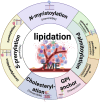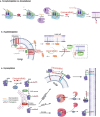Protein lipidation in the tumor microenvironment: enzymology, signaling pathways, and therapeutics
- PMID: 40335986
- PMCID: PMC12057185
- DOI: 10.1186/s12943-025-02309-7
Protein lipidation in the tumor microenvironment: enzymology, signaling pathways, and therapeutics
Abstract
Protein lipidation is a pivotal post-translational modification that increases protein hydrophobicity and influences their function, localization, and interaction network. Emerging evidence has shown significant roles of lipidation in the tumor microenvironment (TME). However, a comprehensive review of this topic is lacking. In this review, we present an integrated and in-depth literature review of protein lipidation in the context of the TME. Specifically, we focus on three major lipidation modifications: S-prenylation, S-palmitoylation, and N-myristoylation. We emphasize how these modifications affect oncogenic signaling pathways and the complex interplay between tumor cells and the surrounding stromal and immune cells. Furthermore, we explore the therapeutic potential of targeting lipidation mechanisms in cancer treatment and discuss prospects for developing novel anticancer strategies that disrupt lipidation-dependent signaling pathways. By bridging protein lipidation with the dynamics of the TME, our review provides novel insights into the complex relationship between them that drives tumor initiation and progression.
Keywords: N-myristoylation; S-palmitoylation; S-prenylation; Lipidation; Tumor microenvironment.
© 2025. The Author(s).
Conflict of interest statement
Declarations. Ethics approval and consent to participate: Not applicable. Consent for publication: Not applicable. Competing interests: The authors declare no competing interests.
Figures







Similar articles
-
Protein Lipidation in Cell Signaling and Diseases: Function, Regulation, and Therapeutic Opportunities.Cell Chem Biol. 2018 Jul 19;25(7):817-831. doi: 10.1016/j.chembiol.2018.05.003. Epub 2018 May 31. Cell Chem Biol. 2018. PMID: 29861273 Free PMC article. Review.
-
Protein Lipidation by Palmitoylation and Myristoylation in Cancer.Front Cell Dev Biol. 2021 May 20;9:673647. doi: 10.3389/fcell.2021.673647. eCollection 2021. Front Cell Dev Biol. 2021. PMID: 34095144 Free PMC article. Review.
-
Protein S-palmitoylation modification: implications in tumor and tumor immune microenvironment.Front Immunol. 2024 Feb 13;15:1337478. doi: 10.3389/fimmu.2024.1337478. eCollection 2024. Front Immunol. 2024. PMID: 38415253 Free PMC article. Review.
-
N-myristoylation: from cell biology to translational medicine.Acta Pharmacol Sin. 2020 Aug;41(8):1005-1015. doi: 10.1038/s41401-020-0388-4. Epub 2020 Mar 18. Acta Pharmacol Sin. 2020. PMID: 32203082 Free PMC article. Review.
-
Regulation of autophagy by protein lipidation.Adv Biotechnol (Singap). 2024 Sep 20;2(4):33. doi: 10.1007/s44307-024-00040-w. Adv Biotechnol (Singap). 2024. PMID: 39883197 Free PMC article. Review.
References
-
- Tate EW, Soday L, de la Lastra AL, Wang M, Lin H. Protein lipidation in cancer: mechanisms, dysregulation and emerging drug targets. Nat Rev Cancer. 2024;24:240–60. - PubMed
Publication types
MeSH terms
LinkOut - more resources
Full Text Sources
Medical

